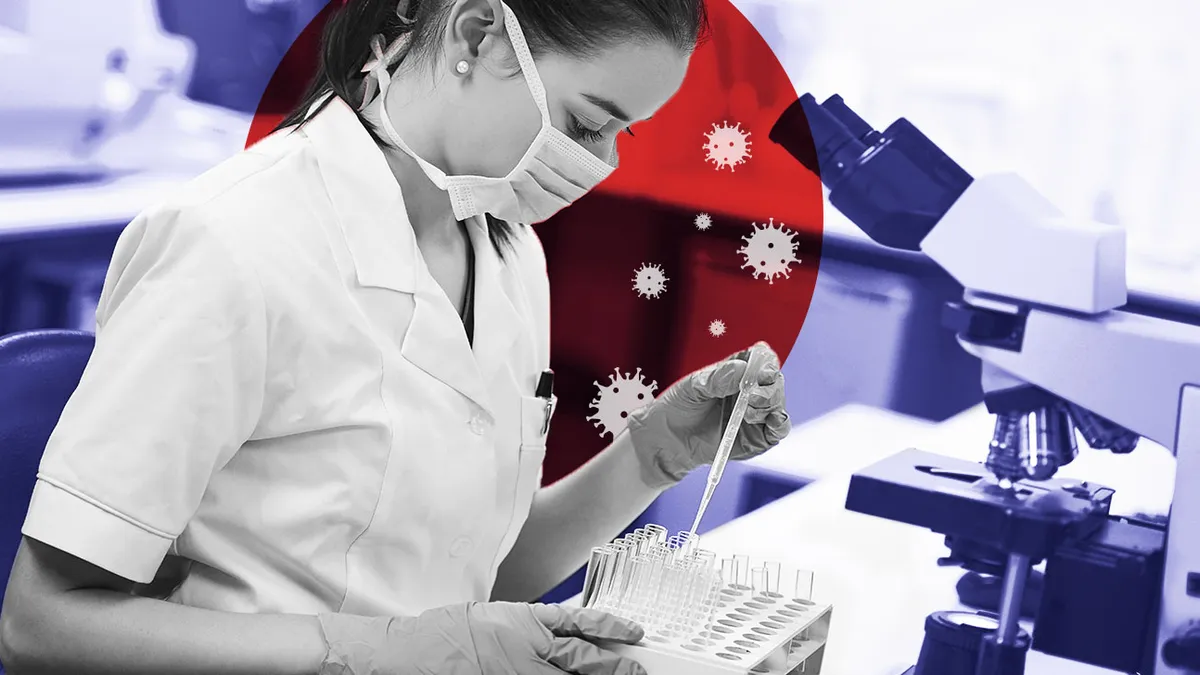This story is part of a MedTech Dive series examining the impact of the COVID-19 pandemic on the medtech industry, published six months after the U.S. declared a public health emergency. You can find the other stories here.
It's hard to think of a product category more critical to America’s ongoing public health response to the coronavirus than the emergency use authorizations granted to in vitro diagnostics for detecting and diagnosing COVID-19.
HHS Secretary Alex Azar’s initial public health emergency declaration in late January and FDA’s subsequent guidance resulted in a flurry of EUAs for diagnostics over the past six months. The agency had given the nod to a total of 188 testing products as of July 24: 155 molecular diagnostics, 31 antibody tests and two antigen tests.
However, the authorization for these products ends when HHS determines the circumstances that justified the public health emergency declaration no longer exist. Given this limited shelf life, manufacturers will need to consider the regulatory requirements to have those products remain on the market.
Manufacturers with IVDs fast-tracked via EUAs during the pandemic will have to go through the FDA’s established 510(k) clearance process to make the full transition onto the U.S. market.
Abbott has received three EUAs from FDA, including an authorization for a rapid point-of-care COVID-19 molecular diagnostic. CEO Robert Ford told investors during a July 16 earnings call that he believes coronavirus testing will "stick around" even when a vaccine is widely available, and, conceivably, when the public health emergency has been lifted.
"I can see patients going to a physician’s office with a fever and they want to know is it influenza, is it the flu, is it COVID. So yes, we think that the capacity that we’re building is not only for, I’d say, high demand during the next 12, 18, 24 months here, but we do see a steady state, as I said, that it will continue to be there," Ford said, though he didn't offer specific plans Abbott might have for seeking 510(k) clearance for their tests.
While HHS late Thursday extended the public health emergency by 90 days, giving a reprieve to all those EUAs, diagnostic makers should take action now if they want their products certified to have a post-pandemic future, according to compliance experts.
The FDA discourages EUAs as a "way of getting on the U.S. market as a quick product launch," according to Sonia Lecce, senior IVD regulatory consultant at NAMSA, a contract research organization for medical device companies.
It's the agency's assumption that an EUA would go through to the 510(k) process with "appropriate studies and compliance," she said, adding that "it's quite frowned upon to be in the emergency market and then pull out."
To date, no COVID-19 assays with EUAs have been 510(k)-cleared by FDA. However, there is precedent from other recent public health emergencies. In May 2019, for example, the agency cleared an InBios test to be marketed in the U.S. for detecting Zika virus antibodies. Previously, the test had been authorized only for emergency use. And in October, FDA cleared via its De Novo pathway a rapid Ebola diagnostic test from OraSure Technologies for use in the U.S. for the first time.
Lecce, for one, believes it’s very unlikely that the premarket approval or De Novo pathway would be required for an EUA coronavirus product since there are many existing viral-detection technologies on the market, unless a manufacturer submits a "brand new testing premise."
With the 510(k) guidance, as opposed to the EUA process, manufacturers should be "prepared for longer lead times, more robust testing, and be able to answer FDA communications that would happen during your pre-submission process,” said Lecce, who points to pre-submission meetings as a good opportunity for manufacturers to confirm their predicate strategy for molecular, serology, and antigen tests with the agency.
Moving from EUA test to 510(k)
The first step for manufacturers as they consider transitioning to 510(k) compliance is to re-evaluate the intended use and to weigh whether the current EUA should be the same for the commercialized product.
“We have many clients that are wanting to optimize their EUA product for their 510(k) and they’ve added features like expanded specimen types or collection methods,” said Lecce, who adds that it comes down to how a manufacturer wants to move forward as a test kit to be sold in the U.S. and its intended use.
Jennifer Tibodeau Jensen, IVD principal project manager at NAMSA, advises getting buy-in across all stakeholders. “The EUA design may not be the design you want to commercialize,” she said, emphasizing that it’s important that the design criteria and specifications are clear and well documented.
COVID-19 assays were developed in mere days, weeks, or at most months. This quick turnaround did not give developers time to fully understand the design, according to Tibodeau Jensen. “The EUA is a very short-term solution, with a 510(k) you’re in it for the long haul so you really want to understand your design and be able to manufacture it.”
She also notes that in the EUA process manufacturers were able to waive some of the quality system requirements. However, with 510(k) clearance, that leniency won’t be the case.
A quality management system is a “foundational piece” of the regulatory process, according to Tibodeau Jensen. In addition, manufacturing processes should be validated with control established over the supply chain and raw materials.
Another important set of considerations is creating a long lead time study to include real-time stabilities for components, the assay, patient samples, as well as developing analytical verification protocols and drafting clinical validation protocols.
“It is very helpful to have a mature draft of your protocols to share with FDA as part of the pre-submission process to gain feedback,” advised Tibodeau Jensen.
Time to gather data
Lecce said the data manufacturers gather now while their EUA tests are in use will be valuable in understanding the assays’ real-world performance, with an eye toward securing 510(k) clearance.
During the EUA process, FDA essentially took at face value the test and safety data submitted by manufacturers seeking authorization for emergency use of their products. Once the public health emergency is over, it's back to business at the agency in terms of holding them to more rigorous data standards.
As part of the 510(k) submission process, IVD makers will be required by FDA to provide “more statistically robust study design to prove the safety and efficacy," Lecce emphasizes, noting that the EUA validation criteria established by the agency are minimums.
Ultimately, a critical undertaking for IVD makers is aligning test activities with their predicate to show substantial equivalence, including sensitivity, specificity, a full stability program, labeling, as well as how the EUA product might differ from manufacturing practices and how that would impact the final product.
"In COVID-19 asymptomatic screening, you need a very high-sensitivity assay to pick up those low prevalence results and diagnostic algorithms such as repeat testing, follow-up testing can in fact help with your diagnostic results," Tibodeau Jensen. "You will obviously need to design your clinical studies to prove the results."
Lecce recommends that manufacturers working on any product related to COVID-19 who have not yet pursued an EUA do so now, even at this late date, and take advantage of the public health emergency process, even if their ultimate intention is to go directly to a 510(k) submission. The goal should be "getting your product into use so that you can start gathering some information with the bottom line question: Does it work appropriately or not?"

















